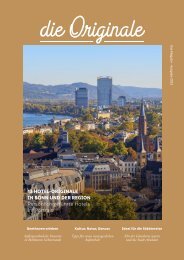LUXAIR_LUXiClub_So12 ls
p o
p
o
You also want an ePaper? Increase the reach of your titles
YUMPU automatically turns print PDFs into web optimized ePapers that Google loves.
Number 43, Fall 2002
cartographic perspectives 49
Figure 4. On NPS maps, physical features are more apt to be portrayed with cartographic realism than
cultural and explanatory map elements.
Figure 5. Mt. Rainier National Park, Washington. (left) Hand-drawn rock hachures. (right) The
hachures are rasterized and lightly filtered in Photoshop to appear more rock like.
organic. Rasterizing also sets the stage for later exotic filter manipulations
that can be applied only to pixels (Figure 5).
3) Modulate tones – Just as lines are rare in nature, so too are perfectly
flat area tones. Seemingly flat surfaces such as water bodies,
ice fields, and deserts contain subtle tonal variations that need to
be emphasized.
4) Texturize – Graphical noise and embossed textures give selected
area tones, such as cliffs and forests and even rasterized lines, a
tactile appearance that more closely mimics nature (Figure 6).
Applying the rules mentioned above to the design of cartographically
realistic maps requires utmost restraint. Not only is the philosophy for
designing realistic maps somewhat different from that of conventional
cartography, so too are the production techniques used to apply these
designs. Although merging physical landscape features can yield spectacularly
realistic results, the potential for a disaster is also high—the
“Modulate tones - Just as lines
are rare in nature, so too are
perfectly flat area tones.
Seemingly flat surfaces such
as water bodies, ice fields, and
deserts contain subtle tonal
variations that need to be
emphasized.”















